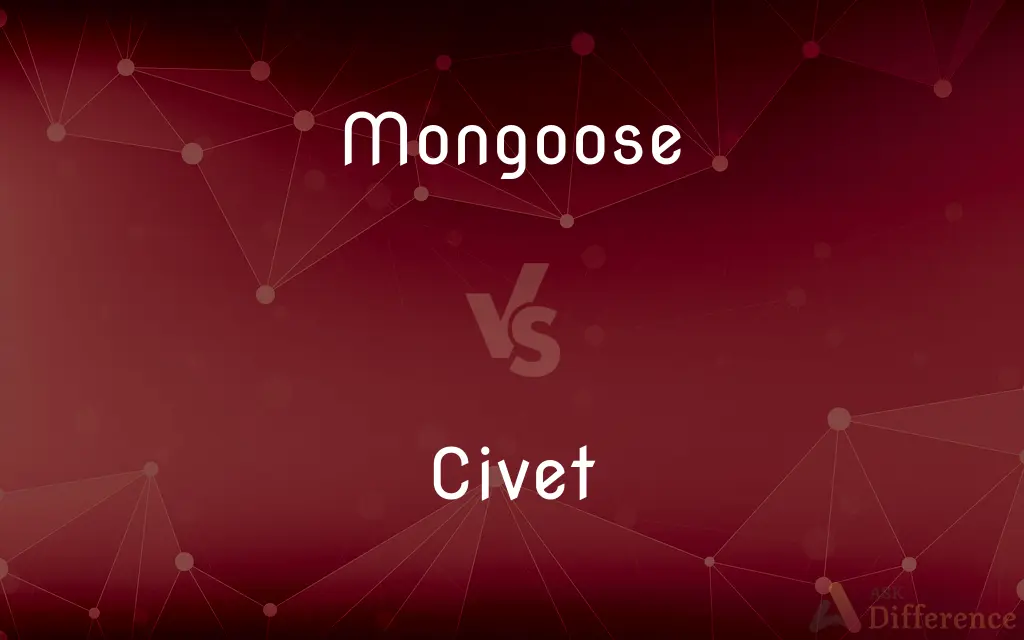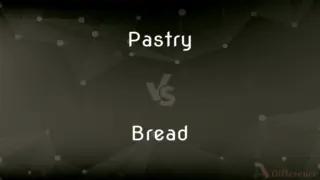Mongoose vs. Civet — What's the Difference?
Edited by Tayyaba Rehman — By Fiza Rafique — Updated on February 27, 2024
Mongoose is a small, agile mammal known for its ability to kill snakes, characterized by its slender body and carnivorous diet, whereas civets are medium-sized, omnivorous mammals, distinguished by their musk-producing glands and more varied diet.

Difference Between Mongoose and Civet
Table of Contents
ADVERTISEMENT
Key Differences
Mongeese (plural for mongoose) belong to the Herpestidae family and are celebrated for their agility and predatory skills, particularly in killing snakes. They have a slender body, sharp teeth, and are primarily carnivorous, feeding on rodents, snakes, eggs, and insects. Civets, on the other hand, are part of the Viverridae family, which is known for its diverse range of species, including the African civet and the Asian palm civet. These animals have a more robust body compared to mongeese and possess anal scent glands that produce musk, a substance used in traditional perfumery and medicine.
Mongeese slender build and quick reflexes aid in their hunting prowess, allowing them to attack venomous snakes with remarkable efficiency. Civets have a varied diet, eating fruits, berries, and small animals, making them omnivorous.
The habitats of mongeese and civets also differ, with mongeese being found in Africa, southern Asia, and southern Europe, often in open forests, grasslands, and scrublands. They are adaptable and can live in close proximity to humans. Civets, however, are mostly found in tropical forests and woodland habitats of Africa and Asia, preferring a more secluded lifestyle.
Behaviorally, mongeese are known for their social structures in some species, living in large groups and displaying complex social behaviors. Civets tend to be more solitary or live in small family units, with social interactions largely limited to mating or raising young.
Conservation statuses vary among species within both families. While some mongoose species are common and not currently at risk, others face threats from habitat destruction and hunting. Civets, particularly the African civet and some species of palm civets, face threats from habitat loss and the pet trade, with certain species being exploited for their musk.
ADVERTISEMENT
Comparison Chart
Family
Herpestidae
Viverridae
Diet
Carnivorous (e.g., rodents, snakes)
Omnivorous (e.g., fruits, small animals)
Body Shape
Slender, agile
Robust, with musk-producing glands
Habitat
Open forests, grasslands
Tropical forests, woodlands
Behavior
Social (in some species)
Solitary or small family units
Conservation
Varies, from common to at risk
Some species exploited, at risk
Compare with Definitions
Mongoose
Primarily carnivorous, feeding on small animals.
Mongeese often hunt rodents and birds for food.
Civet
Medium-sized, omnivorous with a varied diet.
The civet was spotted eating berries in the forest.
Mongoose
Adaptable to various habitats, including human proximity.
Mongeese have adapted to live in agricultural areas.
Civet
Mostly solitary, with nocturnal habits.
Civets are often seen alone at night, foraging for food.
Mongoose
Conservation status varies by species.
The Indian mongoose is common, but others are threatened by habitat loss.
Civet
Produces musk used in perfumery.
Civet musk is a valuable ingredient in traditional perfumes.
Mongoose
Social in some species, living in groups.
A group of mongeese banded together to defend their territory.
Civet
Lives in tropical forests and woodlands.
Asian palm civets are commonly found in rainforest habitats.
Mongoose
Agile predator, known for snake hunting.
The mongoose swiftly attacked the cobra.
Civet
Faces threats from habitat loss and exploitation.
African civets are hunted for their musk, impacting their populations.
Mongoose
A small carnivorous mammal with a long body and tail and a grizzled or banded coat, native to Africa and Asia.
Civet
A civet () is a small, lean, mostly nocturnal mammal native to tropical Asia and Africa, especially the tropical forests. The term civet applies to over a dozen different mammal species.
Mongoose
A mongoose is a small terrestrial carnivorous mammal belonging to the family Herpestidae. This family is currently split into two subfamilies, the Herpestinae and the Mungotinae.
Civet
Any of various catlike mammals of the family Viverridae of Africa and Asia, having anal scent glands that secrete a fluid with a musky odor. Also called civet cat.
Mongoose
Any of various carnivorous mammals of the family Herpestidae, native to Asia, Africa, and southern Europe and introduced elsewhere, having a slender agile body and a long tail, and noted for the ability to seize and kill venomous snakes.
Civet
The animal that produces civet (Viverra civetta); - called also civet cat. It is carnivorous, from two to three feet long, and of a brownish gray color, with transverse black bands and spots on the body and tail. It is a native of northern Africa and of Asia. The name is also applied to other species.
Mongoose
Any of several species of generalist predatory Carnivores in the family Herpestidae; the various species range in size from rats to large cats. The Indian mongoose is noted as a predator of venomous snakes, though other mongoose species have similar habits.
Common Curiosities
What makes mongeese capable of killing snakes?
Mongeese have quick reflexes and agility, along with a certain immunity to snake venom, which enables them to kill snakes effectively.
Why are civets important to the perfume industry?
Civets produce a musk in their anal glands, which is a highly valued ingredient in traditional perfume making for its unique scent.
Can civets be kept as pets?
While civets can technically be kept as pets, it's not recommended due to their specific care needs and the ethical concerns related to wild animals as pets.
Are all mongoose species immune to snake venom?
Not all, but many mongoose species have evolved a certain level of resistance or immunity to the venom of the snakes they hunt.
Are civet populations stable worldwide?
Civet populations vary widely; some species are stable, but others are decreasing due to habitat loss and exploitation.
How do conservation efforts differ for mongeese and civets?
Conservation efforts for mongeese and civets focus on habitat preservation, anti-poaching measures, and, for civets, reducing demand for musk.
How do mongeese communicate?
Mongeese communicate through vocalizations, scent markings, and visual signals to convey messages within their social groups.
How do civets contribute to coffee production?
Asian palm civets are known for their role in producing Kopi Luwak, a coffee made from beans that have passed through their digestive system, enhancing the coffee's flavor.
What role do mongeese play in their ecosystems?
As predators, mongeese help control populations of rodents, snakes, and insects, contributing to the balance of their ecosystems.
What adaptations help mongeese survive in their environment?
Their agility, social structure, and ability to adapt to different habitats help mongeese thrive in various environments.
Can civets and mongeese coexist in the same habitat?
While they may share overlapping ranges, their different lifestyles and dietary needs generally allow them to coexist without direct competition.
What is the biggest threat to civet populations?
The biggest threats include habitat destruction, hunting for musk, and the pet trade, which negatively impact their wild populations.
Do mongeese have natural predators?
Yes, mongeese have natural predators, including larger birds of prey, snakes, and wild cats, depending on their habitat.
Is the musk from civets still used in perfumes today?
Yes, though its use has declined due to ethical concerns and the development of synthetic alternatives, civet musk is still used in some traditional perfumes.
What is the significance of the mongoose in culture and folklore?
The mongoose is often depicted as a symbol of courage and intelligence in folklore, notably in stories like "Rikki-Tikki-Tavi" by Rudyard Kipling.
Share Your Discovery

Previous Comparison
Pastry vs. Bread
Next Comparison
Carrack vs. GalleonAuthor Spotlight
Written by
Fiza RafiqueFiza Rafique is a skilled content writer at AskDifference.com, where she meticulously refines and enhances written pieces. Drawing from her vast editorial expertise, Fiza ensures clarity, accuracy, and precision in every article. Passionate about language, she continually seeks to elevate the quality of content for readers worldwide.
Edited by
Tayyaba RehmanTayyaba Rehman is a distinguished writer, currently serving as a primary contributor to askdifference.com. As a researcher in semantics and etymology, Tayyaba's passion for the complexity of languages and their distinctions has found a perfect home on the platform. Tayyaba delves into the intricacies of language, distinguishing between commonly confused words and phrases, thereby providing clarity for readers worldwide.














































